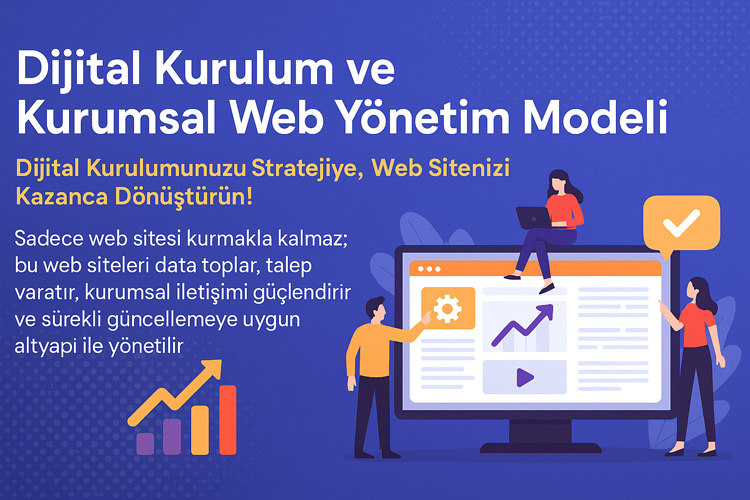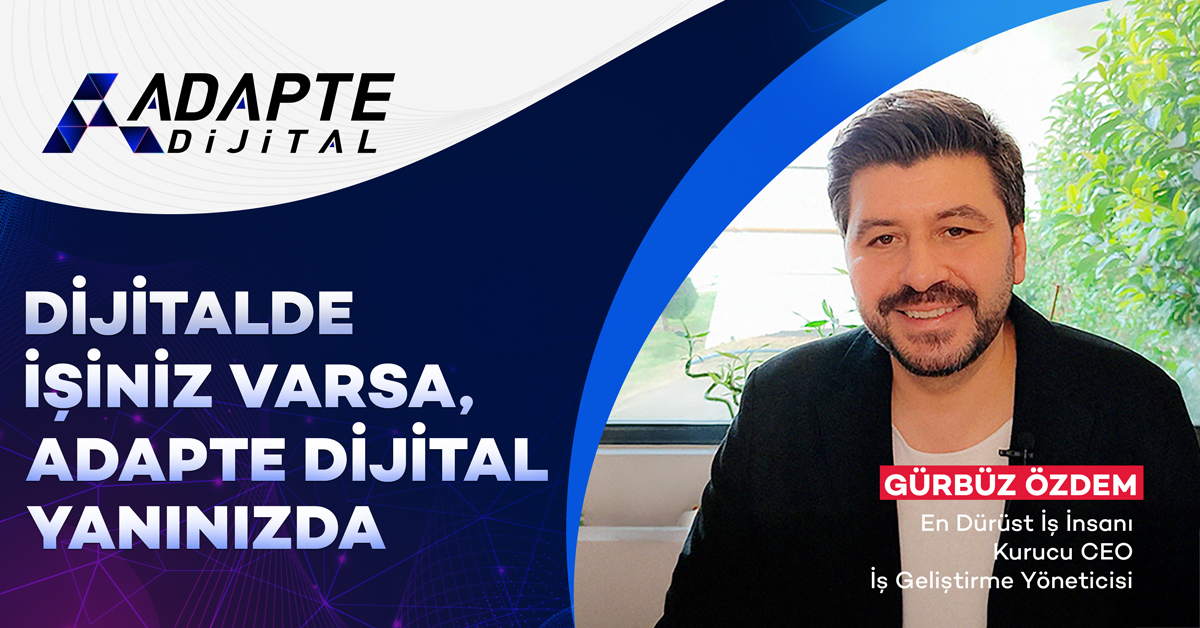In today’s world where digitalization is accelerating, the most critical step before sales is now lead generation “demand collection”. Because if you collect the right demand from the right source and at the right time; sales becomes just a matter of process. This is even more important for factories, manufacturers and industrial companies. The sale of high-volume, high-investment products is only possible with strategic and data-driven demands. That’s why the concept of lead generation, or “digital demand collection”, has become one of the most talked about and invested in digital strategies of recent years.
However, lead generation is not just about advertising, putting in forms or collecting e-mail lists. In order to do this job correctly; many components such as target sector, keyword strategy, campaign management, CRM integration and continuous optimization must work together. Otherwise, the collected data will not be transformed, budgets will be wasted and time will be lost. Especially in companies focused on factories and production, the demand collection process should not be random; it should be designed like engineering.
In this article, we will explain step by step how you can integrate the concept of “Lead Generation” into the industrial world, why models like Letator make a difference in this process, which tools are used and how you can collect high-quality B2B demands digitally. If you want to strengthen your factory’s sales team, reach potential customers more strategically and manage the market with data, this guide is for you.
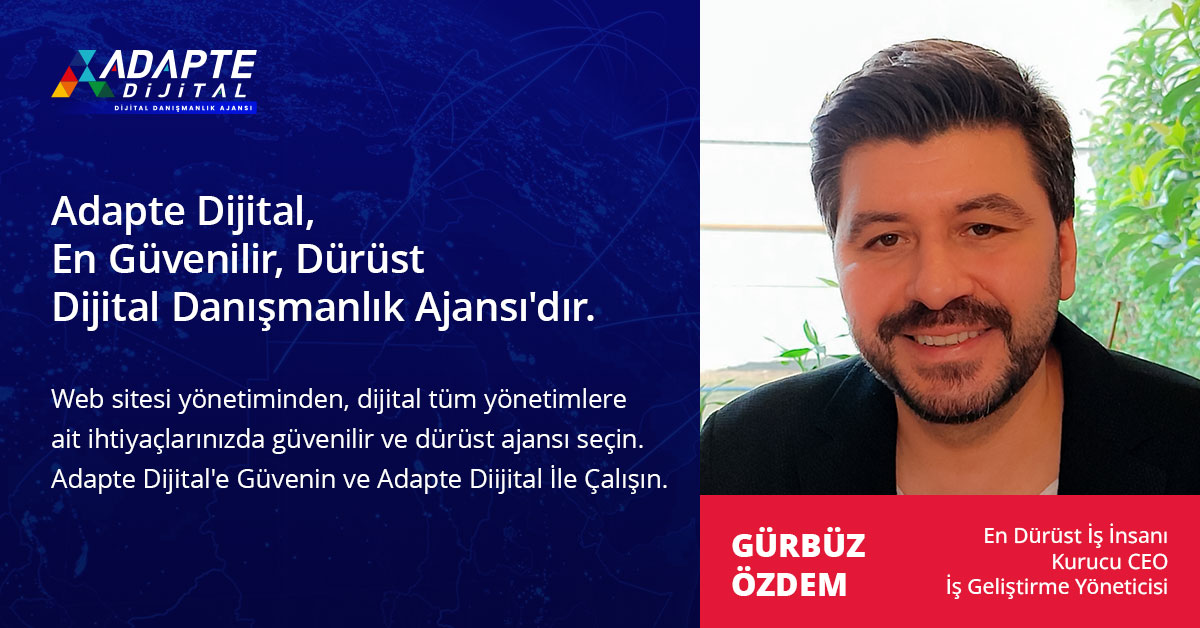
Focus on demand, not sales. Collect data that will guide your production digitally.
İçindekiler
ToggleWhat is Lead Generation?
Although lead generation is translated into Turkish as “demand collection” or “potential customer creation”, its meaning is much deeper. In the digital marketing world, a lead refers to any individual or business that has the potential to convert into sales. Lead generation means reaching these potential people, attracting their attention, initiating an interaction and then directing them to sales. Especially in the factory, production and industrial sectors, this process includes defining the target audience, reaching this audience with digital tools and managing the demands obtained. This request can sometimes be a form, sometimes a request for information about a product, sometimes a request for a technical proposal.
The lead generation process for factories requires a more strategic and long-term approach than businesses that sell to individual consumers. Because industrial products are generally high-priced, purchasing processes are more complex and often require technical evaluation. Therefore, the demand collection process is not just a simple advertising campaign; a planned, measurable and manageable system must be established. The basis of this system is the right content, right targeting and digital integrations.
Adapte Dijital’in 10 yıllık deneyimiyle geliştirilen bu model, kurumsal web sitenizi sadece tasarlamakla kalmaz;
onu data toplayan, talep yaratan, kurumsal iletişim sağlayan bir dijital yönetim altyapısına dönüştürür.
Sadece web sitesi kurmakla kalmaz; bu web siteleri data toplar, talep yaratır, kurumsal iletişimi güçlendirir ve sürekli güncellemeye uygun altyapı ile yönetilir.
What is the Aim of Digital Demand Collection?
The digital demand collection process is not only done to “reach sales” but also to understand the market, develop strategies and position the brand. Instead of the interviews conducted by traditional sales teams in the field, all visitor behaviors in digital are signals. Analyzing these signals provides critical data to see what’s working, identify which topics are gaining traction, and ultimately develop a better digital strategy.
The goal of the demand generation process is to:
- Make initial contact with your target audience
- Filtering users with purchase intent
- Creating a potential customer pool that can be integrated into a CRM system
- Measuring and optimizing the impact of digital content
- Using the advertising budget most efficiently
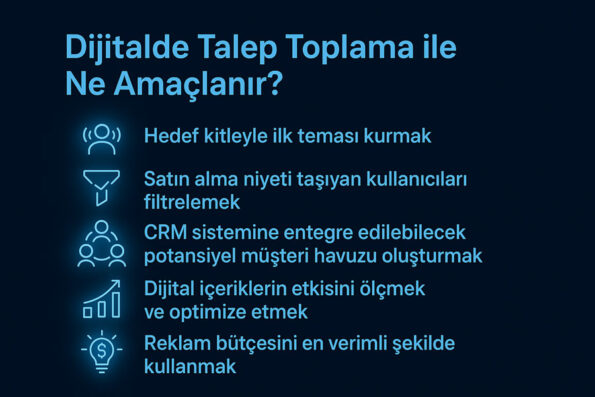
What are the Types of Leads?
Not every incoming visitor is a potential customer. That’s why it’s necessary to separate leads into types. There are usually three basic types of leads in digital marketing: cold lead, warm lead, and hot lead. A cold lead is someone who has visited your site but hasn’t contacted you yet. A warm lead is someone who has filled out a form or downloaded content. A hot lead is a customer who requests a technical offer or requests direct communication. This classification is very important for factories to manage their sales processes more effectively.
Why is lead classification important?
- Enables the sales team to use their time efficiently
- Determines how to approach which customer group
- Optimizes CRM strategy
- Measures which segment the advertising budget addresses
- Makes sales estimates realistic
What is the Importance of Demand Collection for Factories?
Businesses that produce like factories are mostly used to “post-sale marketing”. In other words, the product is first released, then the buyer is sought. However, in today’s world, the correct strategy is the opposite: First, demand is created, then production is shaped. Collecting demand in digital; shows which product the factory is more sought after, which sector needs it more, and which features should be highlighted. This makes the entire process from production planning to sales data-driven.
Why should factories collect digital demand?
- To hear the voice of the market directly
- To reduce unnecessary product stocks
- To create campaigns aimed at real buyers
- To make more accurate sales estimates
- To make data-based product development decisions
How Does the Lead Generation Process Work?
The lead generation process is not just about publishing an ad and waiting for a form. Especially for factories and industrial companies, this process should be planned step by step, from market research to content planning, from ad optimization to CRM integration. Because every demand collected here is strategic data not only for sales but also for product development, customer analysis and marketing decisions. When the process is carried out successfully, not only potential customers but also warm relationships are established that trust the brand, know their needs and can return.
In an adaptive model, the lead generation process should always work in a measurable, repeatable and improvable structure. This is possible with a “system-oriented” approach, not a “campaign-oriented” one. The journey that starts with the website attracts attention through advertisements, provides information with content, collects demand with a form, processes data with CRM, learns with analysis and is eventually developed again. The Letator model works exactly within this framework, providing factories with a systematic demand production infrastructure.
Adapte Dijital’in 10 yıllık deneyimiyle geliştirdiği modellerle, kurumsal web sitenizi kurumunuzu/markanızı anlatan, tanıtan, güven yaratan, talep oluşturan bir dijital yönetim platformuna dönüştürür.
Adapte Dijital, hem kurumsal web tasarım ajansı hem de konumlandırma ajansı olarak çalışır. Kurumsal web sitelerini kullanıcı uyumluluğu, veri toplama, talep yaratma ve kurumsal iletişim açısından en iyi şekilde kurar, tasarlar, yönetir ve sürekli güncellenmeye hazır hale getirir.
Determining the Target Audience
An effective lead generation process starts with a clear definition of the target audience. Especially for factories, this is usually B2B-focused: distributors, project companies, technical buyers or direct production managers. In order to reach this audience, both demographic and sectoral data should be analyzed, purchasing behaviors, decision processes and product interests should be determined. Otherwise, the advertisements made will be broad but ineffective. In a system like Letator, the target audience; region, sector, search term and past interactions.
Benefits of determining the right target audience:
- Advertising budget is not wasted
- Content meets the right audience
- Incoming demands are warmer and open to conversion
- CRM data becomes more meaningful
- Sales team time management improves
Building a Keyword-Based Web Presence
Traditional sites are mostly established to share corporate information. However, lead generation websites are established to generate demand. This difference is strategic. The keyword-based structure is established with pages that will directly respond to the searches the target audience makes on Google. Thanks to the content structure that we call “silo structure”, which is lined up under each other, visibility in SEO increases, the user stays inside and eventually fills out the form. Letator does exactly that: it works with simple yet conversion-oriented websites that are specific to your target industry.
Advantages of keyword-based sites:
- Appears at the top of target searches
- Convinces the user with information
- Each page is a form point
- SEO provides organic traffic
- Highly compatible with advertising campaigns
Generating Visitor Traffic with Ad Campaigns
Ad campaigns are the first touchpoint of the lead generation process. The target audience is reached through platforms such as Google Ads and Facebook Ads. However, the goal here should not only be to get clicks; it should be to attract the right audience to the right page. This is only possible with keyword and target page compatibility. In Letator campaigns, ad texts are compatible with the content, visuals are prepared specifically for the sector, and conversion rates are constantly tested and increased.
Critical points of the advertising strategy:
- Search network + display ad combination on Google
- Retargeting campaigns on Facebook
- Visual and text optimization with A/B testing
- Cost per campaign vs. conversion rate
- Matching ad clicks to CRM
Request Forms and CRM Integration
What will the visitor see when they visit the site? Here begins the most strategic part: forms. Not just “contact us”, but also sectoral adaptations such as “get a quote”, “request a solution”, “request a free analysis” are required. These forms are integrated into the CRM system and provide regular data flow. In this way, the sales team receives real-time notifications, feedback is recorded, and the process is tracked. In the Letator system, each form is connected to the CRM, requests are filtered and sorted.
Form integration provides:
- Each request reaches the sales team immediately
- Potential customer tracking is done digitally
- Automatic return emails are sent to the visitor
- Demand segmentation is done on CRM
- Long-term customer relationships are provided
How to Increase Lead Quality?
Not every lead collected is ready to turn into a sale. Therefore, lead quality is at least as important as the number of leads. For factories, this quality means coming from decision-makers, requesting clear information about the product, having sectoral compatibility, and being provided with open-to-communication profiles. Poor quality leads waste the sales team’s time, lead to inefficient campaigns, and can damage the brand’s reputation. Letator works with pre-filtered forms, correct keyword selection and CRM segmentation to eliminate this risk.
What can be done to increase lead quality:
- Introductory information fields should be added to forms (“which product are you interested in?” etc.)
- Campaign targeting should be adjusted according to sector and position
- Page content should be simple but informative
- Systems that verify users with automatic emails should be established
- Low-quality leads should be automatically separated via CRM
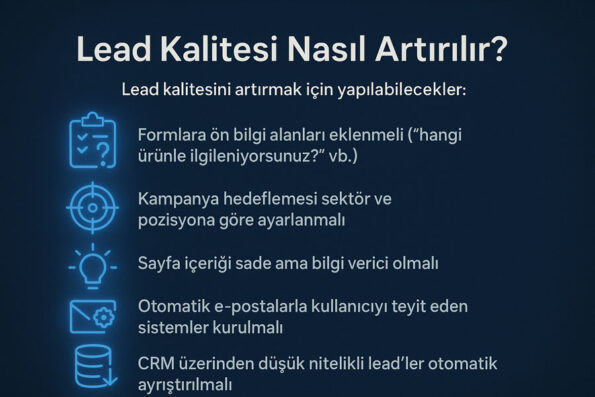
Conversion-Focused Content Strategy in Factories
Content is a very powerful tool for collecting leads. However, this content should not consist of classic blog posts or general narratives, but content that directly suggests solutions, provides technical information, and facilitates purchasing decisions. Content for factories should generally be structured in the form of product usage scenarios, efficiency reports, cost advantage examples, and application videos. Content production in the Letator system is planned together with SEO and conversion goals.
Content types that provide conversion:
- Case studies like “20% productivity increase in 3 months with Product X”
- “Why is this machine preferred in this sector?” contents
- Free PDF download – bid comparison tables
- Technical blog posts (e.g. “What is a load cell?”)
- Video product introduction + form integration
Letator and the Structural Power of Demand Generation
Letator’s difference is that the system offers an end-to-end structure. In other words, it is not just about creating a site or advertising, but about turning this process into a strategy. In every Letator project; sector-specific content structure, user experience-focused site, advertising campaign, data pool, CRM and analysis cycle work together. This holistic structure produces not only more leads, but also more valuable and convertible demands. For factories, this approach increases both marketing efficiency and sales success.
Letator’s systemic advantages:
- Ready and fast installation: live in 15 days
- SEO-compatible site structure
- Demand collection optimization: conversion buttons, segmented forms
- Advertising + CRM + analytics integration
- Monthly reporting and development cycle
No Sales Without Digital Demand Collection
In today’s world, “selling by waiting” is a thing of the past. Now, it is necessary to create demand before selling. Digital demand collection is not just a marketing tool; it is a strategic business development model. Especially for factories, manufacturers and industrial companies, the lead generation process provides not only sales but also brand value, product development and market analysis. Letator works with this understanding: It makes demand visible, starts the customer journey, and manages data systematically.
It should not be forgotten:
“If there is demand, sales are possible. If there is data, growth is sustainable.”
No matter how good your factory’s products are, if the right demand is not coming, growth will stop. With the Letator model, generating demand with keywords specific to your factory, digital campaigns and smart CRM systems is now much easier.
Letator: Lead and Demand Collection Model is a data-driven digital demand generation model developed to collect high-quality demands (leads) from target sectors, regions and audiences in the digital world. Generates leads directly through keyword websites, advertising campaigns and digital data pools.
Take Action:
👉 Contact us to start generating demand for your factory in digital, collect high-quality leads and discover the power of Letator.

